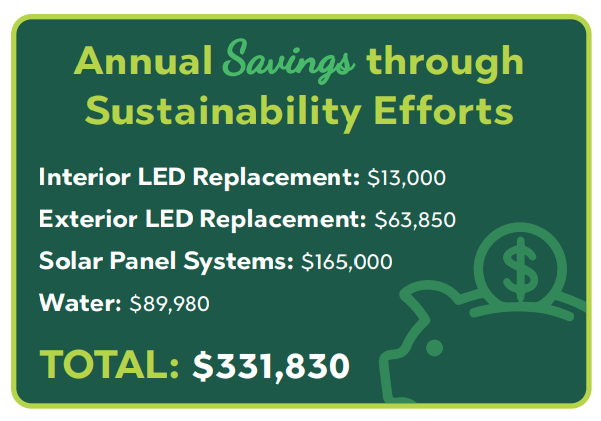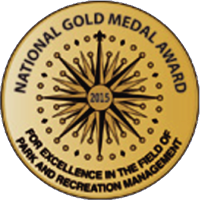sustainability
What does sustainability look like at the Park District?
Sustainability is engraved throughout the Park District of Oak Park. We integrated sustainability into our Comprehensive Master Plan, committed to sustainability as a Core Value, identified key initiatives in our Strategic Plan, and our Sustainability Plan charts a course for future environmental stewardship.
Our biennial Sustainability Plan outlines goals, initiatives, and programs to implement that maintain and further the Park District’s sustainability commitments in ten areas:
- Community and Patron Education and Engagement
- Employee Education, Training, and Engagement
- Fleet Management
- Health and Wellness
- Natural Resources and Habitat Preservation
- Recycling and Solid Waste Management
- Sustainable Acquisition and Use of Agency Supplies
- Sustainable Infrastructure and Natural Areas
- Utility and Energy Conservation
- Water Conservation and Management
Through various initiatives we’ve reduced our environmental footprint, with ongoing efforts to further mitigate resource depletion. Our holistic sustainability strategy includes waste reduction, energy efficiency, green energy production, education, water conservation/reuse, native habitats, green procurement policies, and more. In addition, we calculate dollar savings each year through our sustainability efforts.

Who is responsible for promoting sustainability at the Park District?
The Sustainability Committee, composed of Park District employees, meets regularly to advocate for the Sustainability Plan and work towards accomplishing its goals. In addition, the Environmental Sustainability Advisory Committee contributes to the enactment of these sustainability programs and acts as a communication channel between the Park District and Oak Park residents.
Sustainability Initiatives
Native Plants, Bioswales, Gardens
Four bioswales across the District help prevent the flow of pollutants into freshwater ecosystems and provide a natural way to manage storm water in an urban setting. Over 250 plant species that support pollinators can be found in our bioswales located at the Oak Park Conservatory, Barrie Park, and CRC.
The All-Abilities Garden at Cheney Mansion grows copious amounts of vegetables every summer. The Park District donates over 500 pounds of fresh produce from the garden to the Oak Park River Forest Food Pantry each year.
Solar Panels
Sustainable Facilities
Ridgeland Common Recreation Complex: Gold LEED certification, solar panel system, high efficiency HVAC system, native landscaping, reuse of original roof structure
Carroll Center: Passive House design/certification, Source Zero Energy certification, geothermal system, super insulation, solar panel system, electrical load monitoring, rain garden
Community Recreation Center: All electric, ILFI Net Zero certified, high efficiency VRF/heat pump HVAC system, solar array and battery backup system, high efficiency building envelope, rain garden, permeable pavers, electric load monitoring, daylighting and occupancy lighting and outlets
LED Lighting
Interior Lighting: Converted 38,754 watts to 16,780 watts, which is a 43% reduction in energy usage and an annual savings of $13,000 in energy costs.
Exterior Lighting: Converted the remaining 106 park walk lights, exterior court, and field lights to LED, reducing energy consumption by 587kW per year and saving $63,850 annually.
Water
EV Charging Stations
Carry In/Carry Out
Composting
Additional Sustainability Practices
In 2015-2016, the Park District conducted a study on alternative weed control methods after the Environmental Sustainability Committee made recommendations to consider in place of glyphosate. Check out the study results here!
Oak Park is Illinois’ first and the nation’s fourth municipal arboretum, a designation that came from decades of commitment to nurturing, diversifying, and protecting its urban forest. The Park District of Oak Park and the Village share responsibility for more than 21,000 trees on public property throughout Oak Park’s four and a half square miles.
We use EQ biosolids to keep our fields robust and healthy. Biosolids are a product of wastewater treatment that supplies non-toxic organic matter to our fields when mixed with the topsoil. Visit mwrd.org/biosolids to learn more.
Austin Gardens Environmental Education Center, Carroll Center, and Pleasant Home are powered by geothermal energy, an environmentally-friendly system that uses the Earth’s temperature to provide a highly efficient heating and cooling system all year long.
Completed for all properties using ICLEI software.
The diverse species mix originally planted at Lindberg Park in 2000 was lost due to the invasion of aggressive plant species such as Canada thistle, tall goldenrod and New England aster. The Park District’s Green Advisory Committee worked with the Park District to oversee plans to restore the plantings in the Trial Gardens to recreate the desired plant diversity. The first phase of plantings were completed in June 2012. Successive phasing continues yearly as well as specialized, ongoing maintenance of this unique area.
Contact Patti Staley or Chris Lindgren to learn more.
The Park District partnered with the West Suburban Openlands Treekeepers and the Morton Arboretum to save hundreds of 200- to 300-year old oak trees as part of the Heritage Oak Propagation Program. Grown from acorns back in 2008, a total of 51 of these living treasures were planted in 2015 in Scoville, Mills, Taylor and Field Parks. The nurturing and planting of these trees enhances biodiversity and is part of the District’s broader strategy to use natives whenever possible to best support our environment.
The Park District of Oak Park conducts prescribed burns of the native plant areas for the purpose of improving the health of the plantings. Prescribed burning is perhaps the most important tool in successfully managing restored ecosystems. Because our native plant communities have evolved with periodic fires occurring naturally, the native plant areas in our parks also depend upon regular burning to thrive.
Rain gardens were installed at the Austin Gardens Environmental Education Center, Carroll Park, Stevenson Park, and Euclid Square Park. Similar to a bioswale, rain gardens are planted with deep-rooted native wildflowers, grasses, and shrubs that filter storm water runoff by removing nutrients, sediments, and pollutants before entering groundwater and waterways. Learn more about rain gardens here.
The Park District has a trailer fitted with solar panels that is used to transport electric maintenance equipment from park to park. While equipment is in the trailer, it uses energy collected from the solar panels to charge.
Inoculating trees is the most effective tool for combating Dutch Elm disease, which was decimating our Elm tree population. The Park District invests in our Heritage Elms by inoculating 24 mature, healthy, American Elms per the recommended treatment cycle. The decision was made to treat these trees to try and preserve these living treasures throughout the park system.
The Park District of Oak Park is committed to the highest possible level of management for all natural resources represented in our parks. The Park District maintains a tree inventory identifying the age, condition and location of all trees throughout the parks system using GIS software.
Recognition
The Park District of Oak Park is proud to be the recipient of several awards and distinctions for our sustainability efforts.





